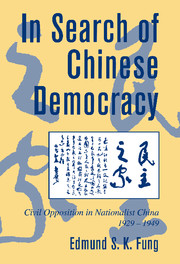Book contents
- Front Matter
- Contents
- Acknowledgments
- A Note on Romanization
- Abbreviations
- Introduction
- 1 The Dictatorial Regime
- 2 Setting the Opposition Agenda: The Issue of Human Rights, 1929–1931
- 3 The National Emergency, 1932–1936: Political and Intellectual Responses
- 4 In Defense of Democracy, 1933–1936
- 5 An Abortive Democratic Experiment: The People's Political Council, 1938–1945
- 6 Wartime Democratic Thought
- 7 The Third Force Movement: The Chinese Democratic League, 1941–1945
- 8 “Peace, Democracy, Unification, and Reconstruction,” 1946
- 9 The Last Stand of Chinese Liberalism
- Conclusion
- Selected Bibliography
- Glossary
- Index
3 - The National Emergency, 1932–1936: Political and Intellectual Responses
Published online by Cambridge University Press: 22 September 2009
- Front Matter
- Contents
- Acknowledgments
- A Note on Romanization
- Abbreviations
- Introduction
- 1 The Dictatorial Regime
- 2 Setting the Opposition Agenda: The Issue of Human Rights, 1929–1931
- 3 The National Emergency, 1932–1936: Political and Intellectual Responses
- 4 In Defense of Democracy, 1933–1936
- 5 An Abortive Democratic Experiment: The People's Political Council, 1938–1945
- 6 Wartime Democratic Thought
- 7 The Third Force Movement: The Chinese Democratic League, 1941–1945
- 8 “Peace, Democracy, Unification, and Reconstruction,” 1946
- 9 The Last Stand of Chinese Liberalism
- Conclusion
- Selected Bibliography
- Glossary
- Index
Summary
After the outbreak of the Mukden incident, China's troubles had only just begun. Before the year 1931 was over, Japan had secured control of part of Manchuria. Then, on the night of January 26, 1932, Japanese naval forces, not to be outshone by the Kantong Army in Mukden, launched an attack on Shanghai. Four days later, the Nationalist government decided to remove its capital to Luoyang, where it remained until December. Early in February, Haerbin was captured by Japanese forces, after which the state of Manzhouguo (Manchukoku in Japanese) was formally set up on March 3, with its capital in Changchun (Jilin). Meanwhile, Chinese troops were forced to abandon Wusong near Shanghai, despite the stiff resistance of the Chinese Nineteenth Route Army and the Fifth Army Corps.
The onset of Japanese aggression brought about a “national emergency” (guonan), which again highlighted the issue of jiuwang. Of course, national salvation entailed resistance to the Japanese. The question was when to take up arms. Following the Mukden incident, the Nationalist government neither resisted the Kantong Army nor entered into any negotiations with Tokyo, choosing to turn to the League of Nations for help. Not wanting to fight the Japanese at this stage, Chiang Kai-shek pursued a policy of “first pacification, then resistance.” Apart from his determination to eliminate the Communists first, Chiang was ill prepared for war against the Japanese army, which inspired awe and fear in him.
- Type
- Chapter
- Information
- In Search of Chinese DemocracyCivil Opposition in Nationalist China, 1929–1949, pp. 82 - 113Publisher: Cambridge University PressPrint publication year: 2000



